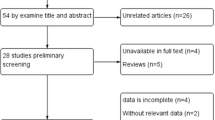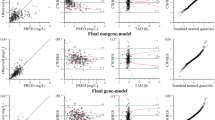Abstract
Purpose
Valproic acid (VPA) is an important drug in seizure control with great inter-individual differences in metabolism and treatment effect. This study aims to identify the effects of genetic variants on VPA clearance in a population pharmacokinetic (popPK) model in children with epilepsy.
Methods
A total of 325 VPA plasma concentrations from 290 children with epilepsy were used to develop the popPK model by using the nonlinear mixed-effects modeling method. The one-compartment model was established to describe the pharmacokinetics of VPA. Twelve single nucleotide polymorphisms involved in the pharmacokinetics of VPA were identified by MassARRAY system and their effects on VPA clearance were evaluated.
Results
In the two final popPK models, inclusion of a combined genotype of four variants (rs1042597, rs28365062, rs4986893, and rs4244285), total daily dose (TDD), and body surface area (BSA) significantly reduced inter-individual variability for clearance over the base model. The inter-individual clearance equals to 0.73 × (TDD/628.92)0.59 × eUGT-CYP for TDD included model and 0.70 × (BSA/0.99)0.57 × eUGT-CYP for BSA included model. The precision of all parameters were acceptable (relative standard error < 32.81%). Bootstrap and visual predictive check results indicated that both two final popPK models were stable with acceptable predictive ability.
Conclusion
TDD, BSA, and genotype might affect VPA clearance in children. The popPK models may be useful for dosing adjustment in children on VPA therapy.

Similar content being viewed by others
References
Begley CE, Durgin TL (2015) The direct cost of epilepsy in the United States: a systematic review of estimates. Epilepsia 56:1376–1387. https://doi.org/10.1111/epi.13084
Loscher W (2002) Basic pharmacology of valproate: a review after 35 years of clinical use for the treatment of epilepsy. CNS Drugs 16:669–694
Budi T, Toth K, Nagy A et al (2015) Clinical significance of CYP2C9-status guided valproic acid therapy in children. Epilepsia 56:849–855. https://doi.org/10.1111/epi.13011
Marahatta A, Bhandary B, Jeong SK, Kim HR, Chae HJ (2014) Soybean greatly reduces valproic acid plasma concentrations: a food-drug interaction study. Sci Rep 4:4362. https://doi.org/10.1038/srep04362
Lin WW, Jiao Z, Wang CL, Wang HY, Ma CL, Huang PF, Guo XZ, Liu YW (2015) Population pharmacokinetics of valproic acid in adult Chinese epileptic patients and its application in an individualized dosage regimen. Ther Drug Monit 37:76–83. https://doi.org/10.1097/ftd.0000000000000100
Ding J, Wang Y, Lin W, Wang C, Zhao L, Li X, Zhao Z, Miao L, Jiao Z (2015) A population pharmacokinetic model of valproic acid in pediatric patients with epilepsy: a non-linear pharmacokinetic model based on protein-binding saturation. Clin Pharmacokinet 54:305–317. https://doi.org/10.1007/s40262-014-0212-8
Williams JH, Jayaraman B, Swoboda KJ, Barrett JS (2012) Population pharmacokinetics of valproic acid in pediatric patients with epilepsy: considerations for dosing spinal muscular atrophy patients. J Clin Pharmacol 52:1676–1688. https://doi.org/10.1177/0091270011428138
Jiang DC, Wang L, Wang YQ et al (2007) Population pharmacokinetics of valproate in Chinese children with epilepsy. Acta Pharmacol Sin 28:1677–1684. https://doi.org/10.1111/j.1745-7254.2007.00704.x
Park HM, Kang SS, Lee YB, Shin DJ, Kim ON, Lee SB, Yim DS (2002) Population pharmacokinetics of intravenous valproic acid in Korean patients. J Clin Pharm Ther 27:419–425
Nakashima H, Oniki K, Nishimura M, Ogusu N, Shimomasuda M, Ono T, Matsuda K, Yasui-Furukori N, Nakagawa K, Ishitsu T, Saruwatari J (2015) Determination of the optimal concentration of valproic acid in patients with epilepsy: a population pharmacokinetic-pharmacodynamic analysis. PLoS One 10:e0141266. https://doi.org/10.1371/journal.pone.0141266
Ogusu N, Saruwatari J, Nakashima H, Noai M, Nishimura M, Deguchi M, Oniki K, Yasui-Furukori N, Kaneko S, Ishitsu T, Nakagaswa K (2014) Impact of the superoxide dismutase 2 Val16Ala polymorphism on the relationship between valproic acid exposure and elevation of gamma-glutamyltransferase in patients with epilepsy: a population pharmacokinetic-pharmacodynamic analysis. PLoS One 9:e111066. https://doi.org/10.1371/journal.pone.0111066
Jiang D, Bai X, Zhang Q, Lu W, Wang Y, Li L, Müller M (2009) Effects of CYP2C19 and CYP2C9 genotypes on pharmacokinetic variability of valproic acid in Chinese epileptic patients: nonlinear mixed-effect modeling. Eur J Clin Pharmacol 65:1187–1193. https://doi.org/10.1007/s00228-009-0712-x
Correa T, Rodriguez I, Romano S (2008) Population pharmacokinetics of valproate in Mexican children with epilepsy. Biopharm Drug Dispos 29:511–520. https://doi.org/10.1002/bdd.636
Birnbaum AK, Ahn JE, Brundage RC, Hardie NA, Conway JM, Leppik IE (2007) Population pharmacokinetics of valproic acid concentrations in elderly nursing home residents. Ther Drug Monit 29:571–575. https://doi.org/10.1097/FTD.0b013e31811f3296
Bondareva IB, Jelliffe RW, Sokolov AV, Tischenkova IF (2004) Nonparametric population modeling of valproate pharmacokinetics in epileptic patients using routine serum monitoring data: implications for dosage. J Clin Pharm Ther 29:105–120. https://doi.org/10.1111/j.1365-2710.2003.00538.x
Serrano BB, Garcia Sanchez MJ, Otero MJ et al (1999) Valproate population pharmacokinetics in children. J Clin Pharm Ther 24:73–80
Guo Y, Hu C, He X, Qiu F, Zhao L (2012) Effects of UGT1A6, UGT2B7, and CYP2C9 genotypes on plasma concentrations of valproic acid in Chinese children with epilepsy. Drug Metab Pharmacokinet 27:536–542
Tan L, Yu JT, Sun YP, Ou JR, Song JH, Yu Y (2010) The influence of cytochrome oxidase CYP2A6, CYP2B6, and CYP2C9 polymorphisms on the plasma concentrations of valproic acid in epileptic patients. Clin Neurol Neurosurg 112:320–323. https://doi.org/10.1016/j.clineuro.2010.01.002
Kiang TK, Ho PC, Anari MR et al (2006) Contribution of CYP2C9, CYP2A6, and CYP2B6 to valproic acid metabolism in hepatic microsomes from individuals with the CYP2C9*1/*1 genotype. Toxicol Sci 94:261–271. https://doi.org/10.1093/toxsci/kfl096
Chu XM, Zhang LF, Wang GJ, Zhang SN, Zhou JH, Hao HP (2012) Influence of UDP-glucuronosyltransferase polymorphisms on valproic acid pharmacokinetics in Chinese epilepsy patients. Eur J Clin Pharmacol 68:1395–1401. https://doi.org/10.1007/s00228-012-1277-7
Hung CC, Ho JL, Chang WL, Tai JJ, Hsieh TJ, Hsieh YW, Liou HH (2011) Association of genetic variants in six candidate genes with valproic acid therapy optimization. Pharmacogenomics 12:1107–1117. https://doi.org/10.2217/pgs.11.64
Jawien W, Wilimowska J, Klys M et al (2017) Population pharmacokinetic modelling of valproic acid and its selected metabolites in acute VPA poisoning. Pharmacol Rep 69:340–349. https://doi.org/10.1016/j.pharep.2016.12.003
Mei S, Feng W, Zhu L, Yu Y, Yang W, Gao B, Wu X, Zhao Z, Fang F (2017) Genetic polymorphisms and valproic acid plasma concentration in children with epilepsy on valproic acid monotherapy. Seizure 51:22–26. https://doi.org/10.1016/j.seizure.2017.07.005
Feng W, Mei S, Zhu L, Yu Y, Yang W, Gao B, Wu X, Zhao Z, Fang F (2016) Effects of UGT1A6 and GABRA1 on standardized valproic acid plasma concentrations and treatment effect in children with epilepsy in China. Ther Drug Monit 38:738–743. https://doi.org/10.1097/ftd.0000000000000337
Shintani M, Ieiri I, Inoue K, Mamiya K, Ninomiya H, Tashiro N, Higuchi S, Otsubo K (2001) Genetic polymorphisms and functional characterization of the 5′-flanking region of the human CYP2C9 gene: in vitro and in vivo studies. Clin Pharmacol Ther 70:175–182. https://doi.org/10.1067/mcp.2001.117367
Buetow KH, Edmonson M, MacDonald R et al (2001) High-throughput development and characterization of a genomewide collection of gene-based single nucleotide polymorphism markers by chip-based matrix-assisted laser desorption/ionization time-of-flight mass spectrometry. Proc Natl Acad Sci U S A 98:581–584. https://doi.org/10.1073/pnas.021506298
Mei S, Li X, Jiang X, Yu K, Lin S, Zhao Z (2018) Population pharmacokinetics of high-dose methotrexate in patients with primary central nervous system lymphoma. J Pharm Sci. https://doi.org/10.1016/j.xphs.2018.01.004
Savic RM, Karlsson MO (2009) Importance of shrinkage in empirical bayes estimates for diagnostics: problems and solutions. AAPS J 11:558–569. https://doi.org/10.1208/s12248-009-9133-0
Yano Y, Beal SL, Sheiner LB (2001) Evaluating pharmacokinetic/pharmacodynamic models using the posterior predictive check. J Pharmacokinet Pharmacodyn 28:171–192
Ette EI, Williams PJ, Kim YH, Lane JR, Liu MJ, Capparelli EV (2003) Model appropriateness and population pharmacokinetic modeling. J Clin Pharmacol 43:610–623
McLeay SC, Morrish GA, Kirkpatrick CM et al (2012) The relationship between drug clearance and body size: systematic review and meta-analysis of the literature published from 2000 to 2007. Clin Pharmacokinet 51:319–330. https://doi.org/10.2165/11598930-000000000-00000
Ghodke-Puranik Y, Thorn CF, Lamba JK, Leeder JS, Song W, Birnbaum AK, Altman RB, Klein TE (2013) Valproic acid pathway: pharmacokinetics and pharmacodynamics. Pharmacogenet Genomics 23:236–241. https://doi.org/10.1097/FPC.0b013e32835ea0b2
de Morais SM, Wilkinson GR, Blaisdell J, Nakamura K, Meyer UA, Goldstein JA (1994) The major genetic defect responsible for the polymorphism of S-mephenytoin metabolism in humans. J Biol Chem 269:15419–15422
De Morais SM, Wilkinson GR, Blaisdell J et al (1994) Identification of a new genetic defect responsible for the polymorphism of (S)-mephenytoin metabolism in Japanese. Mol Pharmacol 46:594–598
Sun D, Jones NR, Manni A, Lazarus P (2013) Characterization of raloxifene glucuronidation: potential role of UGT1A8 genotype on raloxifene metabolism in vivo. Cancer Prev Res 6:719–730. https://doi.org/10.1158/1940-6207.capr-12-0448
Haas DW, Kwara A, Richardson DM, Baker P, Papageorgiou I, Acosta EP, Morse GD, Court MH (2014) Secondary metabolism pathway polymorphisms and plasma efavirenz concentrations in HIV-infected adults with CYP2B6 slow metabolizer genotypes. J Antimicrob Chemother 69:2175–2182. https://doi.org/10.1093/jac/dku110
Ho PC, Abbott FS, Zanger UM, Chang TKH (2003) Influence of CYP2C9 genotypes on the formation of a hepatotoxic metabolite of valproic acid in human liver microsomes. Pharmacogenomics J 3:335–342. https://doi.org/10.1038/sj.tpj.6500210
Strassburg CP, Strassburg A, Kneip S, Barut A, Tukey RH, Rodeck B, Manns MP (2002) Developmental aspects of human hepatic drug glucuronidation in young children and adults. Gut 50:259–265
Reith DM, Andrews J, Parker-Scott S, Eadie MJ (2000) Urinary excretion of valproate metabolites in children and adolescents. Biopharm Drug Dispos 21:327–330
Ginsberg G, Hattis D, Sonawane B, Russ A, Banati P, Kozlak M, Smolenski S, Goble R (2002) Evaluation of child/adult pharmacokinetic differences from a database derived from the therapeutic drug literature. Toxicol Sci 66:185–200
Stewart CF, Hampton EM (1987) Effect of maturation on drug disposition in pediatric patients. Clin Pharm 6:548–564
Silva MF, Aires CC, Luis PB et al (2008) Valproic acid metabolism and its effects on mitochondrial fatty acid oxidation: a review. J Inherit Metab Dis 31:205–216. https://doi.org/10.1007/s10545-008-0841-x
Ponchaut S, van Hoof F, Veitch K (1992) In vitro effects of valproate and valproate metabolites on mitochondrial oxidations. Relevance of CoA sequestration to the observed inhibitions. Biochem Pharmacol 43:2435–2442
Kirchheiner J, Klein C, Meineke I, Sasse J, Zanger UM, Mürdter TE, Roots I, Brockmöller J (2003) Bupropion and 4-OH-bupropion pharmacokinetics in relation to genetic polymorphisms in CYP2B6. Pharmacogenetics 13:619–626. https://doi.org/10.1097/01.fpc.0000054125.14659.d0
Kiyotani K, Yamazaki H, Fujieda M, Iwano S, Matsumura K, Satarug S, Ujjin P, Shimada T, Guengerich FP, Parkinson A, Honda G, Nakagawa K, Ishizaki T, Kamataki T (2003) Decreased coumarin 7-hydroxylase activities and CYP2A6 expression levels in humans caused by genetic polymorphism in CYP2A6 promoter region (CYP2A6*9). Pharmacogenetics 13:689–695. https://doi.org/10.1097/01.fpc.0000054136.14659.be
Yoshida R, Nakajima M, Nishimura K, Tokudome S, Kwon JT, Yokoi T (2003) Effects of polymorphism in promoter region of human CYP2A6 gene (CYP2A6*9) on expression level of messenger ribonucleic acid and enzymatic activity in vivo and in vitro. Clin Pharmacol Ther 74:69–76. https://doi.org/10.1016/s0009-9236(03)00090-0
Wang C, Wang P, Yang LP, Pan J, Yang X, Ma HY (2017) Association of CYP2C9, CYP2A6, ACSM2A, and CPT1A gene polymorphisms with adverse effects of valproic acid in Chinese patients with epilepsy. Epilepsy Res 132:64–69. https://doi.org/10.1016/j.eplepsyres.2017.02.015
Acknowledgements
Thanks are given to our patients.
Funding
Author Weixing Feng was supported by the National Natural Science Foundation of China (No. 81301118).
Author information
Authors and Affiliations
Corresponding authors
Ethics declarations
All procedures performed in studies involving human participants were in accordance with the ethical standards of the institutional and/or national research committee and with the 1964 Declaration of Helsinki and its later amendments or comparable ethical standards.
Conflict of interest
The authors declare that they have no conflict of interest.
Additional information
Shenghui Mei and Weixing Feng are equal first authors.
Rights and permissions
About this article
Cite this article
Mei, S., Feng, W., Zhu, L. et al. Effect of CYP2C19, UGT1A8, and UGT2B7 on valproic acid clearance in children with epilepsy: a population pharmacokinetic model. Eur J Clin Pharmacol 74, 1029–1036 (2018). https://doi.org/10.1007/s00228-018-2440-6
Received:
Accepted:
Published:
Issue Date:
DOI: https://doi.org/10.1007/s00228-018-2440-6




